
Proud of Our People! Vladimir Shukhov: Russian Leonardo
/ Главная / Russkiy Mir Foundation / Publications / Proud of Our People! Vladimir Shukhov: Russian LeonardoProud of Our People! Vladimir Shukhov: Russian Leonardo
Anna Efremova
Vladimir Shukhov, a famous Russian engineer, was born 170 years ago, on August 28, 1853. Contemporaries used to refer to him as "the factory man" and "Russian Leonardo". He designed the first Russian oil pipeline and discovered the oil cracking process. His legacy also includes the remarkably beautiful Shukhov Towers, hyperboloidal structures made of steel mesh envelopes.
"I am a man of life"
Vladimir Shukhov was born in the small town of Grayvoron, Kursk Province. His father served as the governor. Yet, almost immediately after the boy's birth, the Shukhov family moved back to Kursk. Three years later, they moved to St. Petersburg where his father served in the office regulating medical and charitable establishments.
Young Volodya and his older sister were brought up at their grandmother's estate near Kursk. The grandmother was the one who taught the four-year-old boy to read. And soon he manifested his talents as an inventor-to-be. He built a fountain in the house's backyard and a small watermill at the nearby stream.
When the time came to join the grammar school, Volodya moved to his parents in St. Petersburg. In the fourth grade, he suggested to his math teacher an innovative proof of Pythagoras' theorem. Having finished grammar school with honors and succeeded in a tough competition, Vladimir Shukhov was admitted to the Moscow Imperial Technical School (today Bauman Moscow State Technical University) to study at government expense. Soon-to-be engineers were actively exploring industrial practices by working in a turning shop, a locksmith workshop, a foundry, and a blacksmith shop at the School. It was at that time that Mr. Shukhov made his first invention, which was immediately used for practical purposes. The student designed a steam nozzle for liquid fuel combustion. That small part made the combustion process safer and more cost-efficient.
His teachers offered the talented student to pursue science and work at the department. However, Vladimir Shukhov refused those offers as the career of an armchair scientist did not appeal to him. He dreamed of designing practical inventions. "I am a man of life," he used to say.
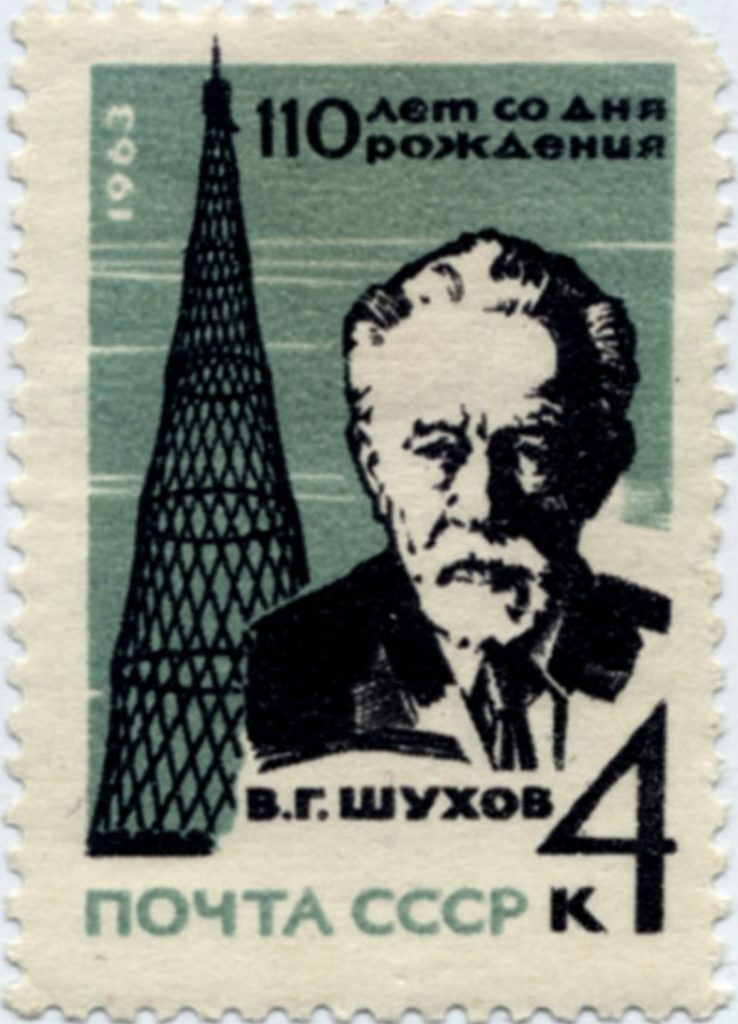
Soviet postage stamp issued in a circulation of 3 million copies for the 110th anniversary of the birth of Vladimir Shukhov
Black City and oil pipelines
Vladimir Shukhov, the best school graduate, joined a delegation to the USA. The 1876 World's Expo had just opened there. The trip was successful in every way. The young specialist explored the latest engineering developments and promising technical ideas and met the person who greatly affected his professional path. It was Russian engineer Alexander Bari who had supervised the construction of pavilions for the World Expo.
A year later, Alexander Bari returned to Russia. He started his cooperation with Ludwig Nobel, a famous Russian businessman, oil industrialist, and brother of the famous founder of the Nobel Prize. Back then, the Nobel brothers owned oil patches in Baku. They invited Vladimir Shukhov, a young engineer, to head the Baku branch of their company. He agreed.
During that time, oil in Baku was extracted by buckets and transported in barrels on two-wheeled carts pulled by oxen. Ludwig Nobel realized that industrial development required the use of modern transportation means. However, other owners of oil patches refused to participate in oil pipeline construction. So, the Nobles' company implemented the project with the help of the construction office of Alexander Bari.
25-year-old Vladimir Shukhov designed Russia's first oil pipeline from Balaxanı to Black City. Later, Vladimir Shukhov published his article "Oil Pipelines" and provided precise mathematical formulas describing how oil and residual flow through pipelines. It became the basis for the classical theory of oil pipelines.
The first Russian oil pipeline was about 6.21 miles (10 kilometers) long and pumped 9148.81 bbl. (1,280 tons) of oil per day with a steam pump. The pipeline reduced transportation costs by more than five times, so its construction was fully recovered within one year only.
Truth be told, there were some criminal cases as well. Owners of carts were losing their profitable business, so they destroyed the pipeline and set it on fire on several occasions. Therefore, watchhouses had to be set up along the entire length of the pipeline. A couple of years later, three more oil pipelines were built under Mr. Shukhov's supervision.
Another invention of the talented engineer brought even more profit. We are referring to the development of the cracking process, i.e. the separation of oil fractions. Until then, oil had been used mainly to produce kerosene for lighting. Gasoline and residual oil were considered industrial waste. Cracking made it possible to produce motor oils, diesel oil, and residual oil during oil distillation. In 1891, Vladimir Shukhov designed and patented the world's first industrial unit for continuous thermal cracking of oil. A few years later, when gasoline-powered vehicles became widespread, Mr. Shukhov's invention was used everywhere in the world.
Vladimir Shukhov also designed and introduced the world's first cylindrical tanks for oil storage. They used to keep oil in open-air storage tanks made of rock or soil before that. In the USA, they started to use rectangular tanks. However, it was cylindrical storage tanks that enabled the use of thinner and lighter metal.
Vladimir Shukhov worked with Alexander Bari for almost 50 years. Remembering that time, Mr. Shukhov described it as follows: "They say that Alexander Bari used to exploit me. That's true. In legal terms, I was always an employee of the office. My remuneration was modest compared to the income that the office received as a result of my efforts. However, I was also exploiting him by compelling him to implement all my suggestions, even the most daring ones!"
The work was always the sense of life for him. Nevertheless, Vladimir Shukhov did not become an unsociable recluse. He enjoyed opera, theater, and chess. He was fond of bicycling and even became the winner of city tournaments. Mr. Shukhov was passionate about photography. Once he wrote in his notebook: "I am an engineer by profession but a photographer in my heart."
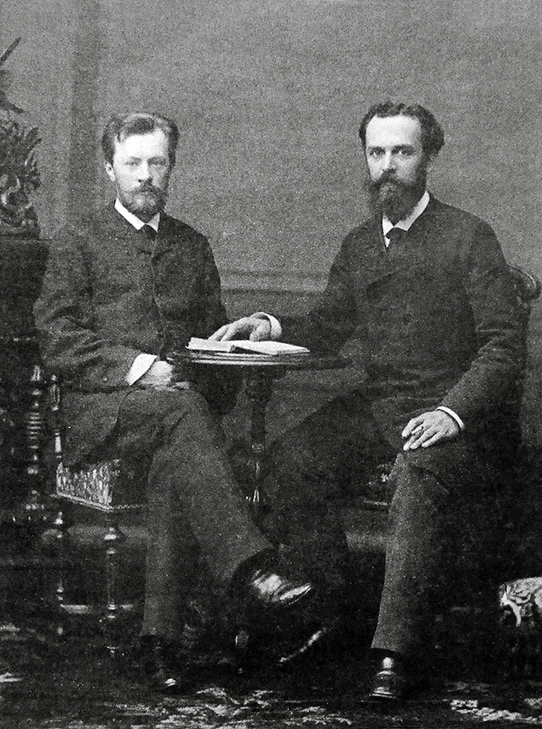
Vladimir Shukhov (left) and Alexander Bari (1880s)
The Hyperboloid of Engineer Shukhov
It was probably his passion for photographic art that inspired engineer Shukhov to design his extraordinary invention combining construction and art - hyperboloid towers made of steel meshes. Metal structures first sparked Mr. Shukhov's interest when he was working on the roofing of the Upper Trade Rows (the present-day GUM Department Store on Red Square). According to contemporaries, the construction was so light and thin that it was reminiscent of a spider web with glass inserted into it.
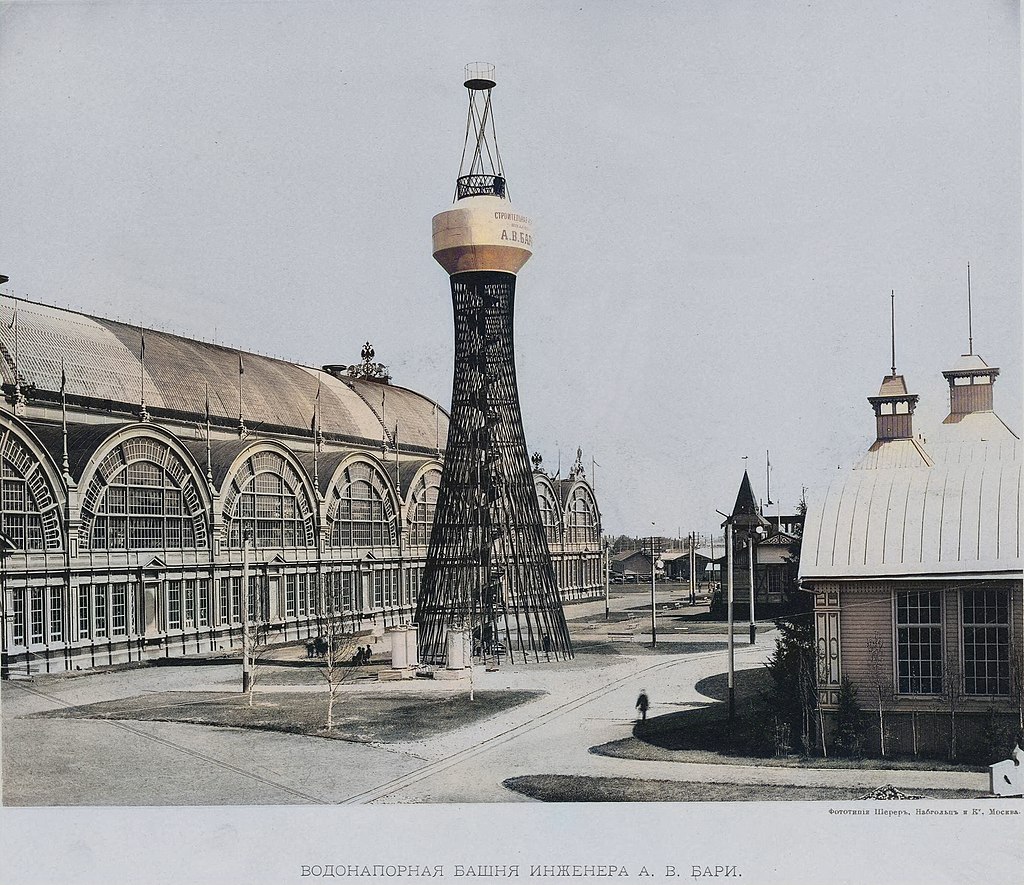
The world's first hyperboloid Shukhov Tower at a Fair in Nizhny Novgorod
In 1896, visitors of the All-Russian Art and Industry Exhibition in Nizhny Novgorod were impressed by Mr. Shukhov's steel membrane pavilion roofs, as well as by his extraordinary design of a water tower in the form of a metal hyperboloid. The incredibly beautiful laced structure turned out to be durable, cheap, and easy to assemble. Its erection required only metal base rings, straight laths, and fasteners. Remarkably, the first Shukhov Tower has survived to this day. It can be found in the Lipetsk Region. It was purchased by a philanthropist and brought there immediately after the exhibition.
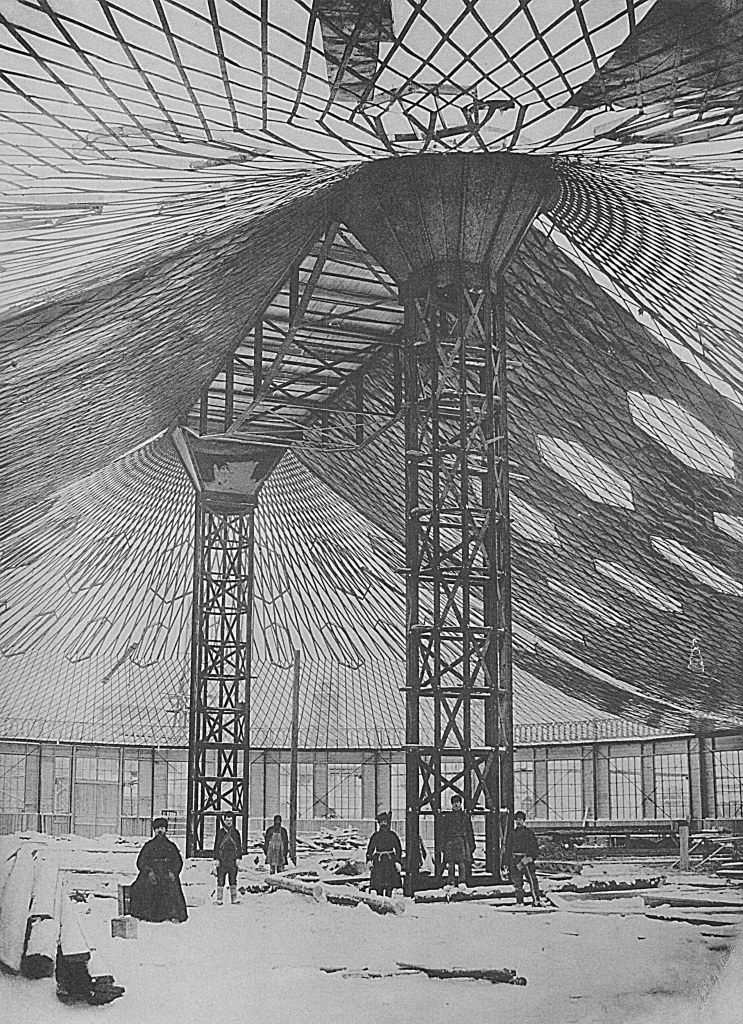
Tensile Steel Lattice Shell of Oval Pavilion for the All-Russian Exhibition in Nizhny Novgorod
Such a steel lattice shell was an innovative form that had never been used in architecture before. Mr. Shukhov shared that he had noticed it in peasant wicker baskets, which were both light and durable. After the Nizhny Novgorod Expo, the engineer used such designs in dozens of various structures, including water towers, sea lighthouses, roofs of public buildings, and bridge spans.
Suspended execution
Certainly, the most well-known structure of this kind was the Shukhov Tower on Shabolovka Street in Moscow.
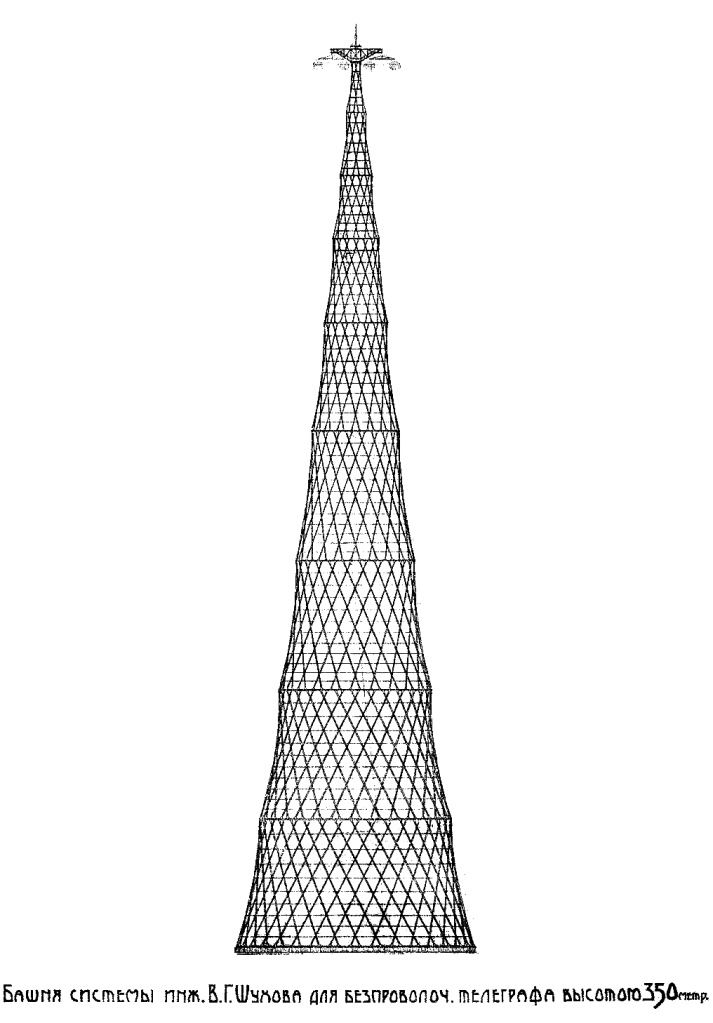
Radio tower project on Shabolovka Street
In 1917, after the October Revolution, Vladimir Shukhov decided to stay in Russia despite receiving many job invitations from abroad. "We must work regardless of politics. Towers, boilers, and rafters are needed, and we will be needed as well," he wrote in one of his letters. Indeed, he commenced construction of a new radio tower commissioned by the Soviet government in 1919, right in the midst of the Civil War. Initially, the tower was to have ten sections and an overall height of 1148 ft or 350 meters (49 ft or 15 meters higher than the Eiffel Tower). However, its dimensions had to be reduced to 486 ft or 148 meters due to the lack of resources. The new project was approved personally by Vladimir Lenin.
The country was in ruins. The metal industry suffered a decline. There was a lack of qualified personnel. Nevertheless, the tower was literally rising. Nikolai Kuznetsov, a Soviet poet, described the erection in verse as follows:
The radio tower rose
for a hundred and fifty meters into the blue sky
Reaching the clouds driven by the wind
and you can see the distant croplands from there.
The ring of the blockade was shrinking,
When our working shoulders
Lifted the tower
Over the Zamoskvorechye.
It doesn't matter that it's a little bit
Lower than the Eiffel Tower,
Still, the clouds kiss its head
while they pass by.
What could be more daring
Then our hard work!
When they attempted to choke us,
We built radio towers.
One day the cable broke. The 4th level of the tower fell to the ground and damaged its other structures. Mr. Shukhov, the construction manager, was accused of sabotage and sentenced to a conditional execution suspended until the completion of construction. However, it turned out that the reason behind the above was the poor quality of metal rather than sabotage. In 1928, Vladimir Shukhov became among the first Heroes of Labor (the title had been introduced in 1927). Today, the Shukhov Tower is rightly considered an architectural masterpiece of the avant-garde era. In November 1941, when fascist troops were approaching Moscow, the tower was mined. There was a plan to detonate the tower. Fortunately, it was not done and the tower survived.
Later on, all major Soviet construction projects were associated with Mr. Shukhov. He implemented the country's electrification plan and designed open-hearth shops of new plants, including Azovstal. In 1932, he directly supervised the launch of "Soviet Cracking", the first oil refinery in Baku. He even restored the ancient minaret after the earthquake in Samarkand by making the "falling" construction straight again. Vladimir Shukhov transferred all rights to his inventions and all royalties to the Soviet state. He passed away at the age of 85 on February 2, 1939.
New publications

 Mikhail Kalatozov, a director who transformed the world of cinematography in many ways, was born 120 years ago. He was a Soviet film official and a propagandist. Above all, he was capable of producing movies that struck viewers with their power and poetic language.
Mikhail Kalatozov, a director who transformed the world of cinematography in many ways, was born 120 years ago. He was a Soviet film official and a propagandist. Above all, he was capable of producing movies that struck viewers with their power and poetic language.  Ukrainian authorities have launched a persecution campaign against the canonical Ukrainian Orthodox Church (UOC), the biggest one in the country's modern history. Over the past year, state sanctions were imposed on clergy representatives, searches were conducted in churches, clergymen were arrested, criminal cases were initiated, the activity of the UOC was banned in various regions of the country, and monasteries and churches were seized.
Ukrainian authorities have launched a persecution campaign against the canonical Ukrainian Orthodox Church (UOC), the biggest one in the country's modern history. Over the past year, state sanctions were imposed on clergy representatives, searches were conducted in churches, clergymen were arrested, criminal cases were initiated, the activity of the UOC was banned in various regions of the country, and monasteries and churches were seized.  When Nektary Kotlyaroff, a fourth-generation Russian Australian and founder of the Russian Orthodox Choir in Sydney, first visited Russia, the first person he spoke to was a cab driver at the airport. Having heard that Nektariy's ancestors left Russia more than 100 years ago, the driver was astonished, "How come you haven't forgotten the Russian language?" Nektary Kotlyaroff repeated his answer in an interview with the Russkiy Mir. His affinity to the Orthodox Church (many of his ancestors and relatives were priests) and the traditions of a large Russian family brought from Russia helped him to preserve the Russian language.
When Nektary Kotlyaroff, a fourth-generation Russian Australian and founder of the Russian Orthodox Choir in Sydney, first visited Russia, the first person he spoke to was a cab driver at the airport. Having heard that Nektariy's ancestors left Russia more than 100 years ago, the driver was astonished, "How come you haven't forgotten the Russian language?" Nektary Kotlyaroff repeated his answer in an interview with the Russkiy Mir. His affinity to the Orthodox Church (many of his ancestors and relatives were priests) and the traditions of a large Russian family brought from Russia helped him to preserve the Russian language.

 The leaders of the Friends of the Great Russia cultural association (Amici Della Grande Russia) in Italy believe that the Western policy of abolishing Russian culture in Europe has finally failed. Furthermore, it was doomed to failure from the beginning.
The leaders of the Friends of the Great Russia cultural association (Amici Della Grande Russia) in Italy believe that the Western policy of abolishing Russian culture in Europe has finally failed. Furthermore, it was doomed to failure from the beginning.  Name of Vladimir Nemirovich-Danchenko is inscribed in the history of Russian theater along with Konstantin Stanislavski, the other founding father of the Moscow Art Theater. Nevertheless, Mr. Nemirovich-Danchenko was a renowned writer, playwright, and theater teacher even before their famous meeting in the Slavic Bazaar restaurant. Furthermore, it was Mr. Nemirovich-Danchenko who came up with the idea of establishing a new "people's" theater believing that the theater could become a "department of public education."
Name of Vladimir Nemirovich-Danchenko is inscribed in the history of Russian theater along with Konstantin Stanislavski, the other founding father of the Moscow Art Theater. Nevertheless, Mr. Nemirovich-Danchenko was a renowned writer, playwright, and theater teacher even before their famous meeting in the Slavic Bazaar restaurant. Furthermore, it was Mr. Nemirovich-Danchenko who came up with the idea of establishing a new "people's" theater believing that the theater could become a "department of public education."  "Russia is a thing of which the intellect cannot conceive..." by Fyodor Tyutchev are famous among Russians at least. December marks the 220th anniversary of the poet's birth. Yet, he never considered poetry to be his life's mission and was preoccupied with matters of a global scale. Mr.Tyutchev fought his war focusing on relations between Russia and the West, the origins of mutual misunderstanding, and the origins of Russophobia. When you read his works today, it feels as though he saw things coming in a crystal ball...
"Russia is a thing of which the intellect cannot conceive..." by Fyodor Tyutchev are famous among Russians at least. December marks the 220th anniversary of the poet's birth. Yet, he never considered poetry to be his life's mission and was preoccupied with matters of a global scale. Mr.Tyutchev fought his war focusing on relations between Russia and the West, the origins of mutual misunderstanding, and the origins of Russophobia. When you read his works today, it feels as though he saw things coming in a crystal ball...